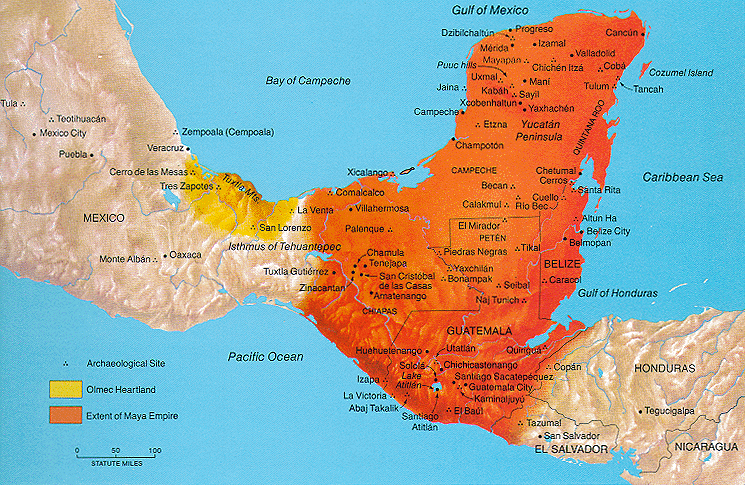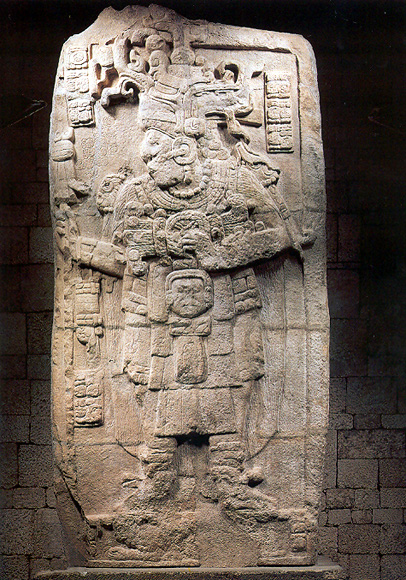 |
| Figure 1: Map of Maya Empire |
Time Periods
Civilizations in Mesoamerica, such as the Ancient Maya are split into different time periods known as the Preclassic, Classic, and Postclassic. Each period is then broken into smaller periods of time. The Preclassic period is the time frame between 2000 B.C.E. and 200 C.E. Within the Preclassic, the Early Preclassic is between 2000 B.C.E. and 1000 B.C.E., the Middle Preclassic is between 950 B.C.E. and 400 B.C.E, and the Late Preclassic is 400 B.C.E. through 200 C.E. (Fagan and Scarre 2008). The Preclassic is often associated with the transition from the Maya people living in small agricultural communities in the Early Preclassic to the development of complex city-states, including elaborate architecture such as pyramids and long distance trade, during the Middle and Late Preclassic period (McKillop 2004).
The Classic period is also broken into three subdivisions. The Early Classic which ranges from 200 C.E. to 600 C.E., the Late Classic which is the time period between 600 C.E. and 900 C.E., and the Terminal Classic period which is from 800 C.E. to 1000 C.E. The Classic period is seen as the peak of Ancient Maya civilization. (Fagan and Scarre 2008) This time period is focused on the beginning and the end of the creation of stone monuments known as stelae. The earliest of these stelae was found at Tikal at the beginning of the Classic period and the most recent stelae created was at the end of the Classic period. These stelae documented, with hieroglyphs, the life story of elite rulers including "birth, marriage, accession to throne, battles won, and death." The Early and Late Classic is also the time period most noted for elaborate plasters, buildings, crafts, and large population growth, while the Terminal Classic is seen as a period of decline for the Ancient Maya. (McKillop 2004)
 |
| Figure 2: Example of a stelae found at Calakmul |
The Postclassic period is only divided into two subdivisions, the Early Postclassic and the Late Postclassic. The Early Postclassic is the time frame from 900 C.E. to 1200 C.E. while the Late Postclassic is from 1200 C.E. to 1500 C.E. (Fagan and Scarre 2008). This period of time is when many of the the prominent Classic sites were abandoned. There is no consensus as to why this occurred but some theories are overpopulation, decline in trade, as well as environmental factors. (McKillop 2004)
What is trade?
"Trade is the exchange of goods and services for other goods and services." Trade can be local or long-distance depending on what goods or services people of a particular area want or need. Trade can be fueled by necessity or by social status. (Andrews 2008)
What was traded?
The Maya people participated in both local and long distance trade. Archaeologists have found evidence of luxury trade items such as jade, ceramics, basalt and obsidian as well as perisherable trade items like cacao, salt, cotton, feathers, animal skins, as well as honey (Smith 2010 and Fagan & Scarre 2008)
Sources:
Andrews, Carolyn. (2008) What is trade?. Crabtree Publishing Company: 1-2
Smith, Michael E. (2010) Trading Patterns, Ancient American. The Berkshire Encyclopedia of World History (2): 1-6
Fagan, B., and C. Scarre. (2008) Ancient Civilizations: 399, 417-429.
McKillop, H. (2004). The ancient Maya : New perspectives. Santa Barbara, California: 7-13
Figure Sources:
Figure 1: Map of Ancient Maya Empire http://www.latinamericanstudies.org/mayas.htm
Figure 2: Stelae 51 from Calakmul http://www.latinamericanstudies.org/maya-stelae-1.htm
Fig
Smi
No comments:
Post a Comment